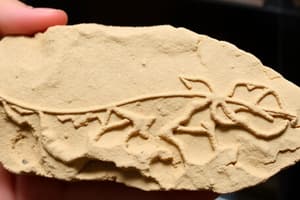Podcast
Questions and Answers
What type of fossil is formed when sediment fills a mold or cast of an organism?
What type of fossil is formed when sediment fills a mold or cast of an organism?
- Compression Fossils
- Replacement Fossils
- Body Fossils
- Casts and Molds (correct)
Which subfield of paleontology studies fossil plants and their evolution?
Which subfield of paleontology studies fossil plants and their evolution?
- Paleoecology
- Biostratigraphy
- Micropaleontology
- Paleobotany (correct)
What is the term for correlating fossils with specific geological time periods?
What is the term for correlating fossils with specific geological time periods?
- Uranium-Lead Dating
- Radioactive Dating
- Biostratigraphy (correct)
- Potassium-Argon Dating
Which type of fossil is evidence of an organism's activity, such as footprints or burrows?
Which type of fossil is evidence of an organism's activity, such as footprints or burrows?
What type of dating determines the exact age of a fossil in years?
What type of dating determines the exact age of a fossil in years?
Which method of fossil dating is used for dating rocks and fossils between 10,000 to 2.5 million years old?
Which method of fossil dating is used for dating rocks and fossils between 10,000 to 2.5 million years old?
Flashcards are hidden until you start studying
Study Notes
Fossils
Types of Fossils
There are several types of fossils, including:
- Body Fossils: Remains of the organism itself, such as bones, shells, or leaves.
- Trace Fossils: Evidence of an organism's activity, such as footprints, burrows, or nests.
- Chemical Fossils: Chemical signatures or isotopic anomalies left behind by an organism.
- Replacement Fossils: Original organic material replaced with minerals, creating a fossilized replica.
- Compression Fossils: Flattened remains of organisms, often preserved in sedimentary rocks.
- Casts and Molds: Fossils formed when sediment fills a mold or cast of an organism.
Paleontology
- Definition: The study of fossils and their context in the geological record.
- Subfields:
- Micropaleontology: Study of microfossils, such as foraminifera and radiolarians.
- Paleobotany: Study of fossil plants and their evolution.
- Paleoecology: Study of fossil communities and ecosystems.
Fossil Dating
- Relative Dating: Determining the age of a fossil relative to other geological events.
- Absolute Dating: Determining the exact age of a fossil in years.
- Methods:
- Biostratigraphy: Correlating fossils with specific geological time periods.
- Radioactive Dating: Measuring the decay of radioactive isotopes, such as uranium-lead or potassium-argon.
- Uranium-Lead Dating: Used for dating rocks and fossils older than 1 million years.
- Potassium-Argon Dating: Used for dating rocks and fossils between 10,000 to 2.5 million years old.
Fossils
Types of Fossils
- Body Fossils are remains of the organism itself, such as bones, shells, or leaves.
- Trace Fossils are evidence of an organism's activity, such as footprints, burrows, or nests.
- Chemical Fossils are chemical signatures or isotopic anomalies left behind by an organism.
- Replacement Fossils are formed when original organic material is replaced with minerals, creating a fossilized replica.
- Compression Fossils are flattened remains of organisms, often preserved in sedimentary rocks.
- Casts and Molds are fossils formed when sediment fills a mold or cast of an organism.
Paleontology
- Paleontology is the study of fossils and their context in the geological record.
- Micropaleontology is the study of microfossils, such as foraminifera and radiolarians.
- Paleobotany is the study of fossil plants and their evolution.
- Paleoecology is the study of fossil communities and ecosystems.
Fossil Dating
- Relative Dating determines the age of a fossil relative to other geological events.
- Absolute Dating determines the exact age of a fossil in years.
- Biostratigraphy correlates fossils with specific geological time periods.
- Radioactive Dating measures the decay of radioactive isotopes, such as uranium-lead or potassium-argon.
- Uranium-Lead Dating is used for dating rocks and fossils older than 1 million years.
- Potassium-Argon Dating is used for dating rocks and fossils between 10,000 to 2.5 million years old.
Studying That Suits You
Use AI to generate personalized quizzes and flashcards to suit your learning preferences.




